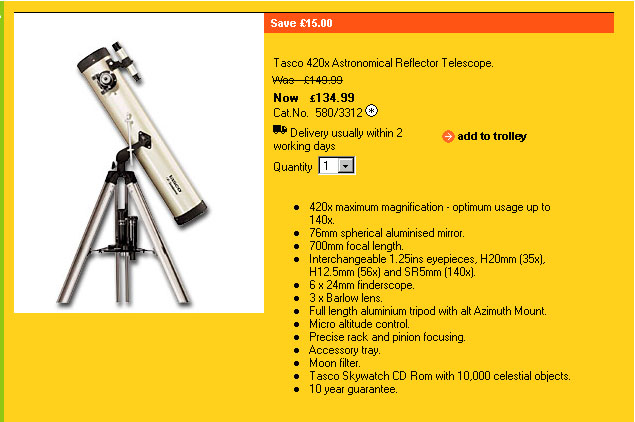Should I buy this small Tasco reflector?
I have attached a pic of a telescope I have seen: what is your opinion of it as a starter scope? – Aswad 
Updated reply
I haven’t tried this particular instrument, but I can tell a lot from the description. Tasco have a poor reputation, and this specification does nothing to improve that reputation! However, I have recently tried a telescope with similar specifications, with the trade name Telstar, and I was quite pleasantly surprised although the telescope did have severe limitations. The Telstar may or may not be from the same stable as the Tasco. It is the same gold colour as the one in the picture. I see that Argos now do not feature this instrument but instead have a Celestron Powerseeker 525 reflector with very similar specifications to the Telstar.76 mm is usually regarded as too small an aperture for a reflector, because the secondary mirror in the centre of the tube, that reflects light out to the eyepiece, has to be rather large relative to the aperture, so cutting down the light reaching your eye. There are quite acceptable Russian reflectors that are even smaller, but in general they are not a good idea. The ad claims 420 x magnification, though it accepts that 140 x is what it calls the optimum. This last bit is now added to overcome the objection that 420 x is far too high a magnification for such a small telescope. The laws of optics don’t allow it, and anyway the view would be too dim to be of use. This is a typical trick to make the telescope sound powerful.
It is also highly unlikely that the 3x Barlow – the lens you use to gain this huge magnification – is colour-corrected, so the result would be virtually unusable, which is why the 420 is just a stupid claim. The Telstar and Celestron instruments with supposed x 525 are also a joke.
The Telstar instrument I used also has a 3x Barlow of no usefulness at all, and just two eyepieces – a 20 mm and a 4 mm Huygenian. These give quite widely separated powers of x 35 and x 175. The view at x 35 was actually perfectly acceptable, though the field of view was very narrow from the Huygenian type eyepiece. At the other end of the scale, the 4 mm eyepiece actually did give an acceptable view of Saturn, showing that the mirror was of reasonable quality. I have seen much worse beginners’ telescopes! However, as mentioned the 3x Barlow was useless and the claimed maximum power of x 525 is just hogwash. The 1.5x erecting eyepiece is also rubbish. The Celestron does have an additional 12.5 mm eyepiece.
With years of experience of dodgy telescopes I could actually use the Telstar at its maximum power. Beginners will struggle with the flimsiness of the mounting and the difficulty of keeping an object in the field of view at high power.The trick is to get the object you want dead centre in the low-power eyepiece, then very quickly slip in the high-power one. Refocus, and you will probably lose the object just as you start to see something. Slip in the 20 mm eyepiece again but don’t refocus – in most cases the object you are viewing will still be visible, if blurred. Recentre it and try the high power again. With luck you can keep the object in view for just long enough to actually see something. And the image is at least free from false colour, unlike the images from cheap refractors.
If you want to enhance the usefulness of the telescope, get a medium-power eyepiece of say 12.5 mm or thereabouts, and also consider a wider-field low-power eyepiece. Look for the secondhand ads. A 20 mm Erfle gave me very pretty views and also made it much easier to find objects because I didn’t need to rely on the tiddly little finder so much. Two eyepieces and a Barlow are a good combination, making sure that you choose them so as to space out the magnifications evenly.
At this end of the market you are always going to be up against flimsy mountings and the totally uncalled-for pointless high powers. OK, the Barlows and erecting eyepieces only cost pence to include, but it would be better to spend those pence on better eyepieces in the first place.
The problem is that if your budget will stretch only to around £100 you are restricted to small refractors or reflectors. If you can afford half as much again the field opens out somewhat, and you can start to get some half-decent telescopes.
http://www.stargazing.org.uk